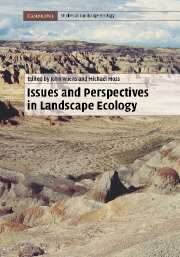Book contents
- Frontmatter
- Contents
- List of contributors
- Preface
- PART I Introductory perspectives
- PART II Theory, experiments, and models in landscape ecology
- PART III Landscape patterns
- PART IV Landscape dynamics on multiple scales
- PART V Applications of landscape ecology
- 18 Landscape ecology as the broker between information supply and management application
- 19 Farmlands for farming and nature
- 20 Landscape ecology and forest management
- 21 Landscape ecology and wildlife management
- 22 Restoration ecology and landscape ecology
- 23 Conservation planning at the landscape scale
- 24 Landscape conservation: a new paradigm for the conservation of biodiversity
- 25 The “why?” and the “so what?” of riverine landscapes
- PART VI Cultural perspectives and landscape planning
- PART VII Retrospect and prospect
- Index
- Plate section
- References
19 - Farmlands for farming and nature
from PART V - Applications of landscape ecology
Published online by Cambridge University Press: 20 November 2009
- Frontmatter
- Contents
- List of contributors
- Preface
- PART I Introductory perspectives
- PART II Theory, experiments, and models in landscape ecology
- PART III Landscape patterns
- PART IV Landscape dynamics on multiple scales
- PART V Applications of landscape ecology
- 18 Landscape ecology as the broker between information supply and management application
- 19 Farmlands for farming and nature
- 20 Landscape ecology and forest management
- 21 Landscape ecology and wildlife management
- 22 Restoration ecology and landscape ecology
- 23 Conservation planning at the landscape scale
- 24 Landscape conservation: a new paradigm for the conservation of biodiversity
- 25 The “why?” and the “so what?” of riverine landscapes
- PART VI Cultural perspectives and landscape planning
- PART VII Retrospect and prospect
- Index
- Plate section
- References
Summary
Since the Second World War, there have been dramatic declines both in the diversity of farmland habitats available to wildlife (animals and plants) and in the quality of the remaining habitat elements. These changes have been brought about by agricultural intensification (i.e., striving for greater output per unit area) and development of the rural–urban fringe. Haphazard growth-management planning has resulted in residential and commercial sprawl that has converted farmlands, fragmented forestlands, increased infrastructure and transportation needs, consumed and compromised wildlife habitat, increased air pollution from more vehicles traveling more miles, and increased water pollution from the widespread use of on-site septic systems. Recent farming policies and technological developments in agricultural practices and their widespread adoption have produced external costs to the environment that are largely borne by non-farmers. In the United States and Canada, both the species richness and abundance of game and non-game wildlife have been adversely affected. Grassland birds, for example, have exhibited steeper and more consistent declines than any other group of birds monitored by the Breeding Bird Survey. In Europe, faunal and floral diversity have been shown to be more threatened on farmland than on almost any other habitat. Of the bird species associated with farmland in Europe, almost half are of conservation concern.
Loss and biotic impoverishment of farmland are concerns because humans depend on the presence and functioning of a diversity of species for services such as pollination, pest control, nutrient cycling, and recreation.
- Type
- Chapter
- Information
- Issues and Perspectives in Landscape Ecology , pp. 193 - 200Publisher: Cambridge University PressPrint publication year: 2005
References
- 2
- Cited by



